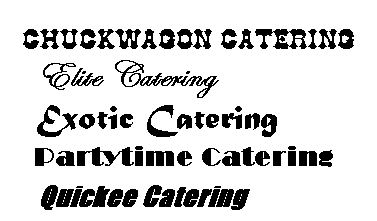
© John Kuraoka, a project of www.kuraoka.com
All brand names are the trademarks of their respective owners.
Site navigation:
Back to the Tightwad Marketing main page
Back to Advertising and marketing advice
Quick finder:
Branding | Business Names | Logotypes | Logos | Recommendations
This article is about your logo - your graphic identity. But, before we can discuss your logo, we have to discuss the marketing upon which that logo will be based. In big business, this is called branding, and it’s what helps a consumer tell, at a glance, a Coke from a Pepsi or a Ford from a Chevy. You don’t have to drink the soda or drive the car to know the difference. Those who argue that there is no difference are further testimony to the strength of branding.
Branding your small business starts before start-up. What? How do you brand your business before it even exists? Simple: by considering brand marketing during your earliest business planning.
Your first marketing consideration, is your competitive edge: the specific way your business will be demonstrably superior to your competition. The key words are specific and demonstrably superior. If you aren’t specific, your planning will lack focus. If your superiority is not demonstrable, it is not real. If you say that you will offer lower prices, for example, then you must be able to prove that your prices are lower. If you say that you will offer higher quality, then you must focus everything you do on providing it. Whatever it is, it must be unique to you.
You will notice that your competitive edge isn’t what you’re going to do, it’s how you’re going to do it. Simply put, it is the reason people should come to you instead of going to your competitor down the street. It is what sets you apart from your competition.
Here are some of the major ways businesses differentiate themselves from their competitors. See if one fits your plans.
No fair saying you’re going to be the largest provider of the widest range of top-quality goods and services at the lowest prices! Even if it was possible, you’d burn out in a month.
Your competitive edge must be the one thing that your business will do better than anyone else. Then, you can build your business plan around how you’re going to actually do it. By focusing on a single competitive edge, you can tell what’s important and what’s not important to your particular enterprise. That kind of thinking even affects the name you give your business!
Back to top
Communicate your competitive edge in your business name. Your business name is your most-important branding tool. It will appear everywhere; on your business cards, signs, vehicles, directory listings, everything. So try to work your competitive edge into your business name. Create a name that tells what is unique about your business. Do this, and you’ll instantly create a distinct image. And that makes both your name and your competitive edge more-memorable.
To show you how this works, let’s pretend there are six hypothetical caterers in the phone book. Here are their names in alphabetical order:
Now, which caterer would you call first if you had a dinner party tomorrow night - Quickee? What if you wanted an outdoor barbecue - Chuckwagon? Something unusual - Exotic? How about to cater a friend’s birthday - Partytime? Your daughter’s lavish wedding dinner - Elite?
See how poor L&S Catering doesn’t get to bid any of these jobs? Next to those other names, “L&S” just seems invisible. It has no image - no branding - built into its business name.
That’s the power of a marketing-oriented business name.
Give your business every chance of success, starting with its name.
Yes, I know, many big companies have names that are nonsensical or nearly so. Kodak. Xerox. eBay. Remember, though, these companies spent lots of time and money establishing their names. And sometimes even they become mixed up about their identities. Xerox computers? What on earth were they thinking?
The right business name not only gives your customers a clear picture of your business, it also gives you a clear picture of your business. That helps prevent you from becoming distracted later.
For example, if the owner of Quickee Catering wanted to expand the business to include an upscale gourmet service, he or she would be wise to maintain the original competitive edge of speed. That affects many aspects of the new service. For instance, the gourmet menu items offered must be quick to prepare, and use only ingredients available year-round. Then, to distinguish the new service while reinforcing the established competitive edge, the owner could give it a separate name: The Quickee Gourmet.
Back to top
Translate your business name and competitive edge into a graphic identity. This is your “look.” It’s the most-obvious part of your brand. You can often communicate your competitive edge through the typeface you use for your business name. Compare these two options for generic-sounding L&S Caterers:

You can see that the top example conveys a fun image, while the bottom example conveys a formal image. This is not to say that either image is better than the other. It is, however, to say that one typeface may be better than another at conveying a particular image or competitive edge. You should choose a typeface based on how well it communicates your competitive edge. Whether you like the typeface is less important than whether it accurately conveys your marketing message to your customers.
When you combine the right typeface with a marketing-oriented business name, you get something that immediately communicates both what you do and how you do it. You get a graphic identity that clearly communicates your competitive edge. For example:

A graphic identity based on type, like these examples, can be highly effective if used consistently. That’s because many business owners, including most of your competitors, don’t know what you now know. What’s more, a graphic identity based on type is a simple solution. In fact, if the examples make sense to you, and you have access to a wide variety of typefaces (or “fonts”), you probably can do it yourself. As you look at various typeface options, always ask yourself these two questions:
However, a graphic identity based solely on type can easily be copied by a competitor. And, if you have a lot of competition, typeface alone may not be enough to set your business apart. That’s when you should consider developing a logo. A logo uses graphic design and art to go one step beyond the above examples. A logo’s visual appeal makes it more eye-catching than just a name, no matter how appropriate the typeface. Your logo, however, must be more than just attractive. It also must be effective. Your logo must communicate your competitive edge more clearly and quickly than your name and typeface do, or there is no advantage gained. Your logo’s first job is business communication, plain and simple.
Although the logo and font used for the business name should go well together, the best logos are those in which the design is either integrated with the business name or capable of standing alone. If the logo design is integrated with the business name, you deliver the full impact of your logo and your business name every time. If the logo design can stand alone, then you can use it on promotional items, such as hats, or as a decorative icon on collateral items such as price tags, stickers, or trim. Either way, it helps build your brand. Too many small business logos are simply nice designs attached to a business name in a complementary type font and color. Try to push beyond that.
When a logo is designed, make sure it works in a variety of formats. The most-flexible proportions seem to be square or nearly square (which includes round and nearly round). If your logo and business name only work together in a continuous horizontal format, it could become too small to read if used in a narrow space. That restricts - or increases the cost of - all your future media buys.
Back to top
Here are ten specific recommendations to strengthening your graphic identity:
A good graphic identity, whether it’s an all-type solution or a custom logo, is the very foundation of your brand. It’s what sets you apart to potential customers before they even know you. Once established, time will only increase in value as a business asset. That’s branding for small business - and tightwads.
Back to top